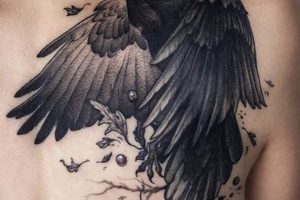The conceptualization and symbolism behind body art comprise a rich and complex field of study. Selecting a design involves considering not only aesthetics but also the personal and cultural significance embedded within the imagery. For example, a simple anchor can represent stability and hope, while a complex mythological scene can tell a personal story or reflect a deeply held belief.
Permanent body modification serves as a powerful form of self-expression and storytelling, allowing individuals to externalize internal narratives and values. Throughout history, cultures worldwide have utilized permanent skin decoration for various purposes, including tribal affiliation, spiritual practices, and social status markers. Understanding the historical context of specific imagery contributes to informed design choices and a deeper appreciation of the art form.
Exploring the myriad options available, from minimalist symbols to elaborate artwork, reveals the extensive possibilities for personal expression. Researching potential designs provides insight into established iconography and opens avenues for creating unique, meaningful body art.
1. Cultural Significance
Cultural significance plays a vital role in the selection and interpretation of body art. Designs often draw inspiration from cultural heritage, mythology, and traditions, imbuing them with layers of meaning that resonate with specific communities. Understanding these cultural connections is crucial for making informed choices and appreciating the rich history behind various motifs.
- Tribal Affiliation
Historically, many cultures used tattoos to denote tribal membership, lineage, and social status. Polynesian tattoos, for example, feature intricate geometric patterns that communicate a wearer’s genealogy and achievements. Similarly, certain Indigenous communities utilize specific animal imagery to represent clan affiliations or spiritual guides. Choosing such designs without understanding their cultural context can be disrespectful and lead to misinterpretations.
- Spiritual and Religious Beliefs
Body art often serves as an outward expression of spiritual or religious beliefs. Mandala tattoos, originating from Hinduism and Buddhism, symbolize the universe and the path to enlightenment. Crosses, icons of saints, and scriptural verses are common expressions of Christian faith. These designs carry deep personal and communal meaning, reflecting individual devotion and shared belief systems.
- Mythological and Symbolic Representation
Myths and legends provide a rich source of inspiration for body art. Images of dragons, phoenixes, and other mythical creatures, prevalent in various cultures, often represent strength, wisdom, or rebirth. Similarly, natural elements like flowers, trees, and celestial bodies can hold symbolic meaning related to growth, resilience, or the interconnectedness of life. Understanding these symbolic associations adds depth and complexity to the chosen design.
- Cultural Appropriation Considerations
In an increasingly interconnected world, cultural exchange and appreciation are vital. However, it’s essential to distinguish between appreciation and appropriation. Adopting imagery from another culture without understanding its significance can be disrespectful and perpetuate harmful stereotypes. Careful research and respectful engagement with cultural traditions are necessary to avoid misusing culturally significant designs.
Respectful consideration of cultural context is paramount when selecting body art. Recognizing the historical and cultural significance embedded within various designs ensures that the chosen imagery resonates authentically with personal values and avoids unintended misinterpretations or cultural insensitivity.
2. Personal Symbolism
Personal symbolism lies at the heart of meaningful body art. While cultural and historical contexts inform design choices, imbuing a tattoo with personal significance transforms it from mere decoration into a powerful expression of individuality. This connection between personal meaning and chosen imagery elevates the tattoo into a deeply personal narrative etched onto the skin. The process of selecting a design based on personal experiences, beliefs, and values transforms the act of tattooing into a ritual of self-discovery and affirmation. For example, a specific flower might represent a loved one, a date might commemorate a significant life event, or a geometric pattern might embody a personal philosophy. The meaning embedded within the design resonates deeply with the individual, creating a lasting connection to the embodied symbolism.
The transformative power of personal symbolism extends beyond individual expression. Shared symbols can foster connection and understanding between individuals. Matching tattoos, chosen to represent shared experiences or values, solidify bonds between friends or family members. Similarly, tattoos commemorating shared struggles or triumphs can create a sense of community and solidarity among individuals who have experienced similar life events. These shared symbols serve as visual reminders of interconnectedness and shared human experiences, strengthening interpersonal relationships and fostering a sense of belonging.
Harnessing the power of personal symbolism requires introspection and careful consideration of the intended message. The permanence of tattoos underscores the importance of selecting imagery that resonates deeply and authentically with one’s values and identity. Thoughtful reflection on personal experiences, beliefs, and aspirations ensures that the chosen design remains meaningful and relevant throughout life’s journey. While trends and aesthetics can influence design choices, prioritizing personal symbolism ensures that the tattoo remains a powerful and enduring expression of self.
3. Artistic Style
Artistic style significantly impacts the visual representation and overall effect of a tattoo, influencing how its meaning is perceived and interpreted. The chosen style should complement the intended message and resonate with the individual’s aesthetic preferences. Understanding the nuances of various artistic styles empowers informed decisions, ensuring the final result aligns seamlessly with both the desired aesthetic and symbolic intent.
- Realism
Realistic tattoos strive to replicate the appearance of photographs or real-life objects with meticulous detail and shading. This style excels at portraying portraits, animals, and natural scenes, creating lifelike representations on the skin. Choosing realism emphasizes the visual accuracy of the subject, lending itself well to designs intended to capture a specific likeness or evoke a sense of natural beauty. However, the complexity of realistic tattoos often requires larger canvases and skilled artists capable of capturing intricate details.
- Traditional
Traditional tattooing, rooted in the early 20th century, features bold lines, vibrant colors, and iconic imagery such as anchors, roses, and eagles. This style often carries symbolic weight, with established meanings associated with specific motifs. Choosing a traditional style evokes a sense of classic tattoo artistry, embracing a time-honored aesthetic. Its bold lines and vibrant colors ensure visibility and longevity, making it a suitable choice for designs intended to make a strong statement.
- Watercolor
Watercolor tattoos mimic the fluid and translucent qualities of watercolor paintings, creating dreamlike and ethereal effects. This style offers a softer, more artistic approach, lending itself well to abstract designs, floral motifs, and depictions of natural elements. Choosing watercolor adds a touch of artistic flair, emphasizing fluidity and vibrancy. However, its delicate nature requires careful consideration of placement and potential fading over time.
- Geometric
Geometric tattoos utilize precise lines, shapes, and patterns to create visually striking designs. This style often draws inspiration from sacred geometry, mandalas, and abstract art, offering a modern and minimalist aesthetic. Choosing geometric designs emphasizes symmetry, balance, and precision. Its versatility allows for intricate patterns or simple, impactful shapes, making it suitable for various body placements and personal preferences.
Selecting an appropriate artistic style is crucial for effectively conveying the intended meaning and achieving the desired aesthetic. The interplay between style and symbolism enhances the overall impact of the tattoo, ensuring it resonates both visually and personally. Carefully considering these elements results in a piece of body art that serves as a powerful and enduring expression of self.
4. Placement Considerations
Placement significantly influences the overall impact and interpretation of body art. Careful consideration of placement integrates the design seamlessly with the body’s contours, affecting visibility, aesthetic appeal, and even the perceived meaning. Strategic placement enhances the interplay between design and body, transforming the tattoo into a cohesive and harmonious expression of personal style and narrative.
- Visibility and Discretion
Visibility plays a key role in how a tattoo is perceived and presented. Highly visible placements, such as hands, necks, and forearms, project a bold statement, readily sharing the design with the world. Conversely, less visible areas, like the back, ribs, or thighs, offer discretion, allowing individuals to control when and where their body art is displayed. Choosing between visibility and discretion depends on personal preferences, professional considerations, and the intended message conveyed by the design.
- Body Contours and Aesthetics
The natural curves and contours of the body provide a dynamic canvas for tattoo placement. Skilled artists consider these contours to enhance the design’s flow and aesthetic appeal. A long, flowing design might gracefully wrap around a limb, while a smaller, symmetrical design might find a harmonious home on the chest or back. Integrating the design with the body’s natural shape creates a cohesive and visually pleasing result, transforming the tattoo into an extension of the individual’s form.
- Symbolic Placement and Meaning
Placement can further enhance the symbolic meaning embedded within a tattoo. A heart tattoo placed over the physical heart amplifies its message of love and emotion. A tattoo representing strength or protection might be placed on the shoulder or arm, symbolizing these qualities. Thoughtful placement adds another layer of depth and significance, transforming the tattoo into a powerful and resonant visual metaphor.
- Practical Considerations and Aftercare
Practical considerations, such as healing time and potential exposure to sunlight, also influence placement decisions. Areas with higher movement or friction may require longer healing periods. Exposure to sunlight can affect ink vibrancy over time, making certain placements more susceptible to fading. Understanding these practical aspects ensures proper aftercare and preserves the tattoo’s longevity and aesthetic integrity.
Placement considerations are integral to the overall success and meaning of a tattoo. Strategic placement enhances the design’s aesthetic impact, strengthens its symbolic resonance, and ensures its harmonious integration with the body. By considering these factors, individuals transform their body art into a powerful and enduring expression of personal identity and narrative.
Tips for Choosing Meaningful Body Art
Selecting permanent body art requires careful consideration. These tips offer guidance for navigating the process thoughtfully and ensuring a meaningful outcome.
Tip 1: Research Thoroughly
Comprehensive research is paramount. Explore various designs, styles, and artists. Understanding the historical and cultural context of potential designs prevents unintended misinterpretations and ensures informed choices.
Tip 2: Reflect on Personal Significance
Connect the chosen design to personal values, experiences, and beliefs. Imbuing the tattoo with personal meaning transforms it from mere decoration into a powerful symbol of self-expression.
Tip 3: Prioritize Quality Artistry
Seek skilled and reputable artists specializing in the desired style. A skilled artist executes the design with precision and artistry, ensuring a high-quality, lasting result.
Tip 4: Consider Placement Carefully
Placement impacts visibility, aesthetics, and symbolic meaning. Evaluate body contours, lifestyle, and professional considerations when choosing placement.
Tip 5: Plan for Long-Term Care
Permanent body art requires ongoing care. Understand proper aftercare procedures and sun protection practices to maintain the tattoo’s vibrancy and integrity over time.
Tip 6: Budget Appropriately
High-quality tattoos represent an investment. Budget accordingly, recognizing that skilled artistry and quality materials often come at a higher price point.
Tip 7: Avoid Impulsive Decisions
Permanent body art requires thoughtful consideration. Avoid impulsive decisions driven by trends or fleeting impulses. Take time to reflect on the design’s long-term significance.
Careful planning and thoughtful consideration ensure that body art remains a source of personal meaning and aesthetic satisfaction for years to come. These tips empower individuals to navigate the process mindfully, resulting in a piece of body art that truly reflects their unique identity and narrative.
By following these guidelines, individuals can embark on the journey of acquiring body art with confidence and intention, ensuring a result that resonates deeply and stands the test of time.
Frequently Asked Questions
This section addresses common inquiries regarding the selection and interpretation of meaningful body art.
Question 1: How does one choose a design that remains meaningful over time?
Selecting timeless designs involves focusing on personal values, beliefs, and experiences rather than fleeting trends. Designs rooted in personal significance tend to resonate throughout life’s journey.
Question 2: What factors influence the cost of a tattoo?
Several factors affect pricing, including size, complexity, artist experience, studio location, and materials used. Larger, more intricate designs requiring specialized skills typically command higher prices.
Question 3: How can cultural sensitivity be maintained when choosing a design from another culture?
Thorough research and respectful engagement with the culture of origin are essential. Understanding the historical and symbolic context of the design prevents misappropriation and demonstrates cultural respect.
Question 4: What are the key considerations for tattoo placement?
Placement depends on factors such as visibility preference, body contours, symbolic meaning, and practical considerations like healing time and sun exposure.
Question 5: How does one find a reputable and skilled tattoo artist?
Recommendations, online portfolios, and consultations provide insights into an artist’s skill level, style, and hygiene practices. Thorough research ensures selecting an artist who aligns with individual preferences and standards.
Question 6: What are the potential risks associated with tattooing?
Potential risks include infections, allergic reactions, and scarring. Choosing a reputable studio adhering to strict hygiene protocols minimizes these risks. Consulting a dermatologist before getting a tattoo is advisable for individuals with pre-existing skin conditions.
Careful consideration of these frequently asked questions ensures a well-informed approach to selecting and acquiring meaningful body art. Understanding these aspects empowers individuals to make responsible decisions that align with their personal values and aesthetic preferences.
Further exploration of specific design ideas and their symbolic meanings provides additional guidance in the journey toward self-expression through body art.
Conclusion
Exploring the multifaceted landscape of tattoo ideas and meanings reveals the profound potential of body art as a form of self-expression and storytelling. Careful consideration of cultural significance, personal symbolism, artistic style, and placement transforms permanent skin decoration into a powerful reflection of individual identity and values. Understanding the historical context and symbolic weight associated with various designs ensures informed choices that resonate deeply and authentically.
Body art serves as a lasting testament to personal narratives, beliefs, and experiences. Thoughtful selection and execution elevate tattooing beyond mere aesthetics, transforming it into a powerful medium for communicating personal truths and forging connections with broader cultural and historical narratives. The permanence of this art form underscores the importance of informed decision-making, ensuring that chosen designs remain relevant and meaningful throughout life’s journey.







